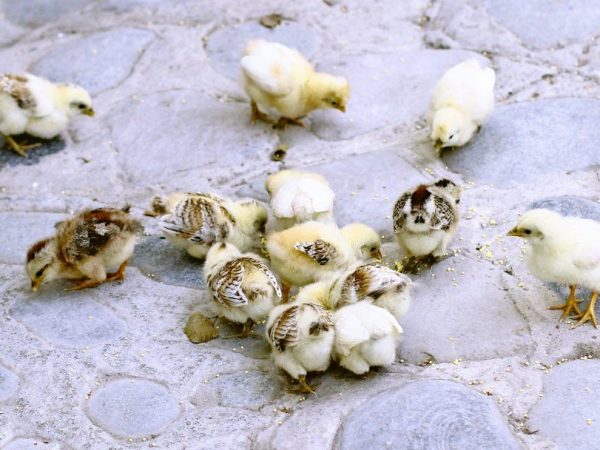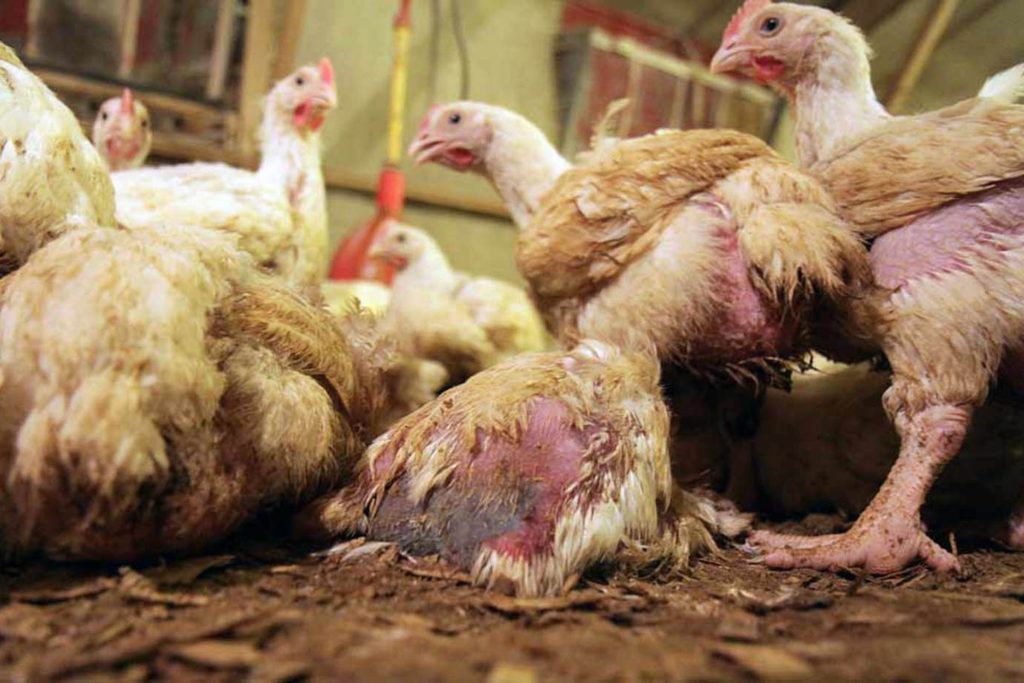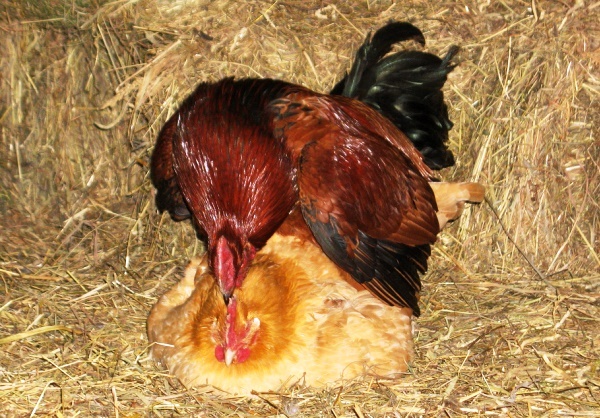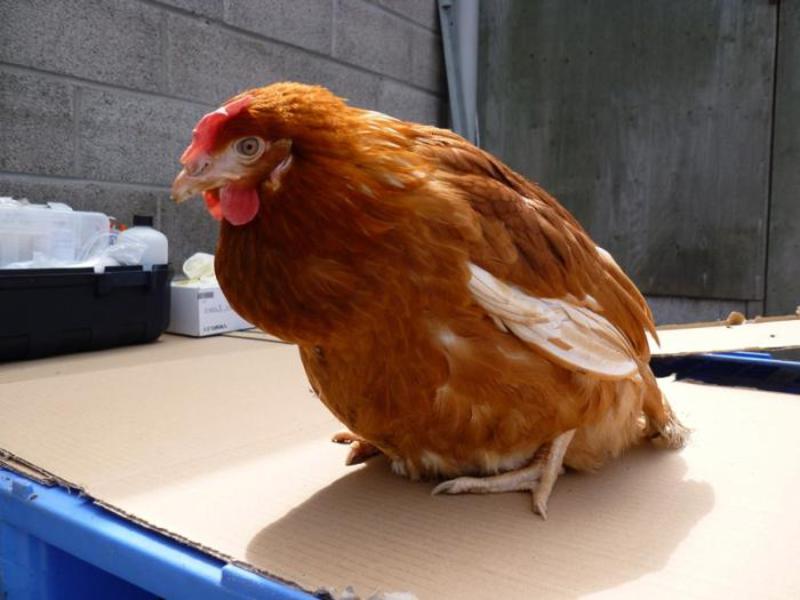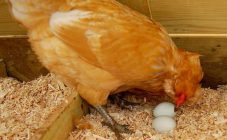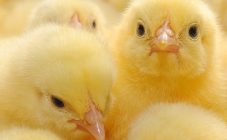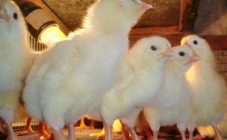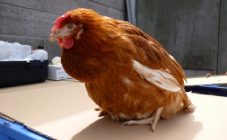Content:
Many owners of private yards raise chickens, both regular chickens and broilers. Various problems arise during the growing process. Often the owners ask if the chickens bite each other until they bleed, what to do. There are general principles for dealing with the problem.
Rules for growing chickens and broilers
Growing broilers and regular chickens is slightly different as it has opposite goals. Broilers are bred for meat, so the main goal is to build up meat, when breeding chickens - to get eggs.
It is important to provide them with excellent living conditions. Growing begins with raising chickens. At first, they should be kept in a room where the temperature does not drop below + 30 ° C, while providing round-the-clock lighting. After 2 weeks, babies will get stronger and can gradually get used to normal conditions. Closer to the age of one month, they will form completely. The room where the chickens are kept must be regularly ventilated, since the peculiarity of meat breeds is low mobility, which leads to the rapid development of infections.
When growing broilers, two methods of housing can be used: floor and cage.
Cellular method
Growing in cages will be the ideal solution for broilers in the country. It is convenient even in terms of sanitation and hygiene. If one bird is infected with an infection, it does not necessarily spread to the rest.
When kept in cages, the following standards must be observed for each square meter:
- no more than 18 chickens;
- no more than 9 adult chickens.
Outdoor content
The method is almost the same for regular chickens and broilers. The difference lies in the temperature setting.
Layers are more tolerant to temperature extremes, while broilers react very strongly to this (the temperature should be 28-35 degrees). In one and the second case, the humidity is maintained at 70%. Walking meat breeds are not too necessary, but chickens should be outdoors regularly.
In the room where the birds will be kept, it is recommended to cover the floor with lime. You will need 1 kg per square. A litter of sawdust and straw is laid on top. It changes regularly.
Nutrition
It is important for broilers to provide a balanced nutritious diet, this is the only way to increase the required meat mass in a short time (growing period - 50-70 days). Feeding begins from the first days of life. From the very beginning, the feeders are filled with chopped boiled eggs and millet, gradually adding green food. From day 5, they begin to give vitamins, chalk and crushed stones are mixed into the feed. If you organize food correctly, then after 8 weeks the bird will gain up to 1.5 kg. The grown-up broilers are fed with compound feed.
The nutrition of laying chickens does not differ from the diet of broilers, since young crumbs need to strengthen their immunity as much as possible and provide it with nutrients.
To raise chickens, food should be organized in such a way as to increase productivity, i.e. egg production. For this, adults are fed 3-4 times a day at regular intervals. The diet of chickens can be varied with compound feed, chicken, grain. To obtain the maximum number of eggs from each head, mineral feed must be present in the diet.
Why chickens peck each other
If cannibalism occurs in chickens, what to do, do not think for a long time. First, you should determine the cause of the aggression. It is a reaction in the form of abnormal behavior to internal or external changes.
Initially, physically stronger individuals begin to peck other birds, and then the phenomenon spreads to the rest. Mass pecking is terrible, as birds can even peck out internal organs. Chickens peck to death in a few hours the weak. The paws, tail and head are most often affected initially.
The reasons why chickens and chickens peck each other can be divided into several groups:
- caused by content;
- caused by nutrition;
- other reasons.
Most often, biting can begin due to the high density of heads per square meter. In this case, growth deteriorates, access to food and water is hampered, which maximizes the development of cannibalism.
Climate change can also affect behavior. If you do not comply with the requirements for humidity, the feather and skin will begin to dry, there may be areas of irritation that the birds want to peck. They attract other individuals that begin to peck.
In open-air cages, domestic chickens have a problem with the distribution of hierarchy. This is what leads to biting.
Of the reasons caused by nutrition, it should be noted:
- In broilers, this behavior can be driven by diet changes or water shortages.
- Small chickens, with a lack of certain substances, begin to peck their own feathers and eat it, but stronger birds pluck feathers from weak ones.
- If the diet contains a large amount of protein food (or lack of) cannibalism cannot be avoided. Therefore, it is important to remember that the diet does not contain more than 35% of corn and similar products.
There are a number of other points that can also provoke bird biting.:
- the presence of wounds in weaker chickens;
- the appearance of new individuals in the hen house;
- a large number of roosters in one room;
- too high a temperature;
- from the place of keeping chickens it is not possible to remove the dead individuals in time;
- the appearance of ticks and other parasites in feathers;
- temperature differences between day and night.
What to do if biting occurs
There is a list of recommendations on how to treat cannibalism in chickens. It is determined initially where the problem comes from, then treatment begins. The flock of birds is divided into 2 parts. The most aggressive chickens that can peck others should be removed to a separate enclosure. And for wounded chickens, therapeutic measures should be taken: stop bleeding, treat bloody wounds with antiseptics (birch tar, potassium permanganate solution, baneocin, brilliant green), and then dry.
You can wean you from pecking each other by reducing lighting. The first time you should turn on the light only for walking and feeding.To prevent birds from noticing wounds, infrared or red lighting can be used in chicken coops.
It is not recommended to keep individuals of different ages together. If you need to accustom the young to a chicken coop, then they are planted in a new place in the evening.
It is important to observe the density of the heads:
- under the age of 21 days, about 120 cm should be provided for each bird;
- at the age of 3-10 weeks, a chicken requires 200 sq. cm;
- up to 17 weeks, 330 sq. m.
How to properly trim the beak of chickens
Another way to combat cannibalism is to debrik the beak, that is, when the tip is cut off. When feeding, the bird takes what it needs with its beak, but when pecking other individuals, it beats it.
The most common way is to trim using hot blades. The operation can be carried out from 1 day of life; in adult chickens, the beak should be debarked in emergency cases.
In some cases, the procedure is performed using a laser, but this is an expensive method, the use of which is not always justified.
Most common questions
Chickens peck not only each other, sometimes unique situations arise that require an individual approach.
Rooster pecks a chicken on the head
There may be several reasons why a rooster pecks a chicken in the head. Most likely, this is a weak or new bird, which the herd does not accept and repeats the action of the leader. If traditional methods don't work, you can try the next option. The neck, head, comb of a regularly suffering bird are smeared with chloramphenicol ointment, which is very bitter, but completely safe. Because of this taste, the aggressors quickly lose interest in the victim.
The rooster beats the same chicken
This behavior of a chicken can be due to two reasons:
- The chicken is sick.
- The rooster wants to persuade a particular individual to have sexual intercourse.
Initially, you need to carefully start observing the behavior of the chicken, if suspicions of health problems are confirmed, then contact the veterinarian. It is important to plant the affected chicken in a separate place, after a while after the cure, they try to return it to the total mass.
Chickens chasing a rooster
If the chickens began to chase the rooster after living together, then action should be taken immediately. First of all, wounds are healed with antiseptics. Chickens are very good at distinguishing red and are eager to taste. Most likely, the rooster developed a wound and the birds reacted to the blood. Therefore, all wounds should be masked with antiseptics, for example, brilliant green.
Chickens peck man
Sometimes the rooster not only bites its neighbors in the chicken coop, but also people. It's important to start reacting right away. You can try to cajole an aggressive bird with treats, but this does not always work. The most effective way is to organize aviaries for the birds so that they do not walk on their own. True, aggression will not disappear.
An effective way is to use plastic glasses. They will make the bird confused and have no time for people. You can use the fasting method. The aggressor is put in a separate cage and is not visited for about 2 days. It is important to leave the water on so that depletion does not occur. If isolation is carried out immediately after the attack, then the bird will quickly realize its mistake.
In conclusion, I would like to note that cannibalism among birds is a fairly frequent phenomenon that should be combated. The best option is to exclude, if possible, the reasons that contribute to the emergence of cannibalism.
